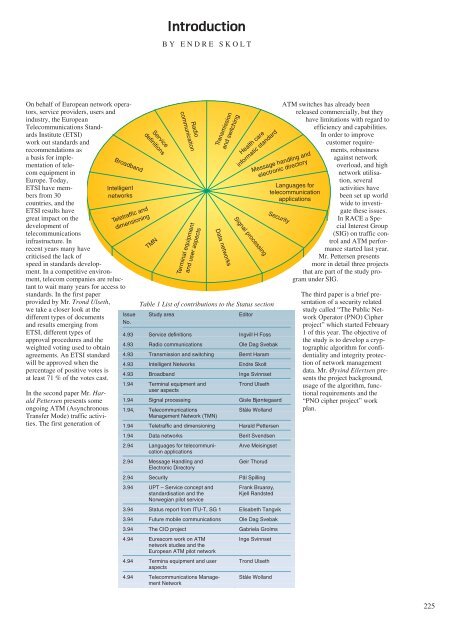Contents Telektronikk - Telenor
Contents Telektronikk - Telenor
Contents Telektronikk - Telenor
Create successful ePaper yourself
Turn your PDF publications into a flip-book with our unique Google optimized e-Paper software.
On behalf of European network operators,<br />
service providers, users and<br />
industry, the European<br />
Telecommunications Standards<br />
Institute (ETSI)<br />
work out standards and<br />
recommendations as<br />
a basis for implementation<br />
of telecom<br />
equipment in<br />
Europe. Today,<br />
ETSI have members<br />
from 30<br />
countries, and the<br />
ETSI results have<br />
great impact on the<br />
development of<br />
telecommunications<br />
infrastructure. In<br />
recent years many have<br />
criticised the lack of<br />
speed in standards development.<br />
In a competitive environment,<br />
telecom companies are reluctant<br />
to wait many years for access to<br />
standards. In the first paper<br />
provided by Mr. Trond Ulseth,<br />
we take a closer look at the<br />
different types of documents<br />
and results emerging from<br />
ETSI, different types of<br />
approval procedures and the<br />
weighted voting used to obtain<br />
agreements. An ETSI standard<br />
will be approved when the<br />
percentage of positive votes is<br />
at least 71 % of the votes cast.<br />
In the second paper Mr. Harald<br />
Pettersen presents some<br />
ongoing ATM (Asynchronous<br />
Transfer Mode) traffic activities.<br />
The first generation of<br />
Broadband<br />
Intelligent<br />
networks<br />
Teletraffic and<br />
dimensioning<br />
Service<br />
definitions<br />
TMN<br />
Introduction<br />
BY ENDRE SKOLT<br />
Radio<br />
communication<br />
Terminal equipment<br />
and user aspects<br />
Data networks<br />
Transmission<br />
and switching<br />
Health care<br />
informatic standard<br />
Signal processing<br />
Table 1 List of contributions to the Status section<br />
Issue Study area Editor<br />
No.<br />
ATM switches has already been<br />
released commercially, but they<br />
have limitations with regard to<br />
efficiency and capabilities.<br />
In order to improve<br />
customer requirements,<br />
robustness<br />
against network<br />
Message handling and<br />
electronic directory<br />
overload, and high<br />
network utilisation,<br />
several<br />
activities have<br />
been set up world<br />
wide to investigate<br />
these issues.<br />
In RACE a Special<br />
Interest Group<br />
(SIG) on traffic control<br />
and ATM performance<br />
started last year.<br />
Mr. Pettersen presents<br />
more in detail three projects<br />
that are part of the study program<br />
under SIG.<br />
Languages for<br />
telecommunication<br />
applications<br />
Security<br />
4.93 Service definitions Ingvill H Foss<br />
4.93 Radio communications Ole Dag Svebak<br />
4.93 Transmission and switching Bernt Haram<br />
4.93 Intelligent Networks Endre Skolt<br />
4.93 Broadband Inge Svinnset<br />
1.94 Terminal equipment and<br />
user aspects<br />
Trond Ulseth<br />
1.94 Signal processing Gisle Bjøntegaard<br />
1.94, Telecommunications<br />
Management Network (TMN)<br />
Ståle Wolland<br />
1.94 Teletraffic and dimensioning Harald Pettersen<br />
1.94 Data networks Berit Svendsen<br />
2.94 Languages for telecommunication<br />
applications<br />
Arve Meisingset<br />
2.94 Message Handling and<br />
Electronic Directory<br />
Geir Thorud<br />
2.94 Security Pål Spilling<br />
3.94 UPT – Service concept and Frank Bruarøy,<br />
standardisation and the<br />
Norwegian pilot service<br />
Kjell Randsted<br />
3.94 Status report from ITU-T, SG 1 Elisabeth Tangvik<br />
3.94 Future mobile communications Ole Dag Svebak<br />
3.94 The CIO project Gabriela Grolms<br />
4.94 Eurescom work on ATM<br />
network studies and the<br />
European ATM pilot network<br />
Inge Svinnset<br />
4.94 Termina equipment and user<br />
aspects<br />
Trond Ulseth<br />
4.94 Telecommunications Management<br />
Network<br />
Ståle Wolland<br />
The third paper is a brief presentation<br />
of a security related<br />
study called “The Public Network<br />
Operator (PNO) Cipher<br />
project” which started February<br />
1 of this year. The objective of<br />
the study is to develop a cryptographic<br />
algorithm for confidentiality<br />
and integrity protection<br />
of network management<br />
data. Mr. Øyvind Eilertsen presents<br />
the project background,<br />
usage of the algorithm, functional<br />
requirements and the<br />
“PNO cipher project” work<br />
plan.<br />
225

















